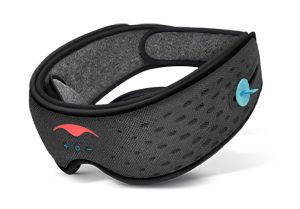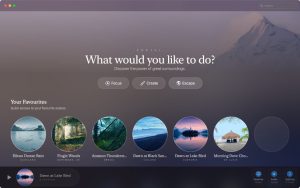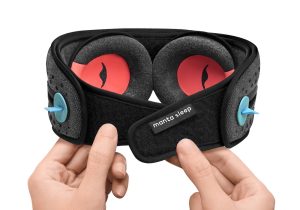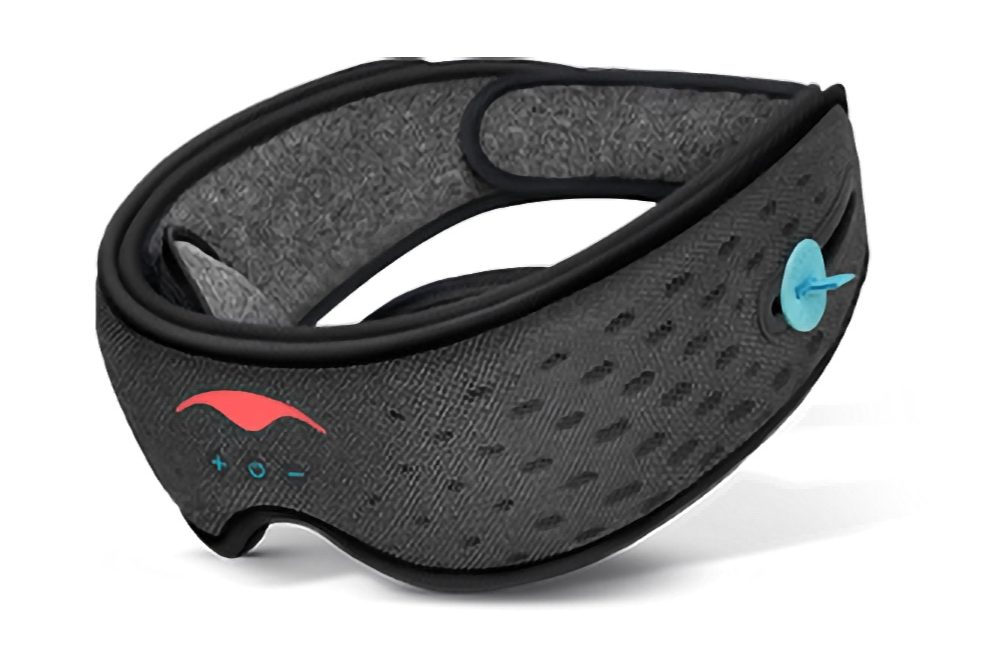I have lived in my current home for over 20 years. In that time I have often complained — usually to friends and family, but also to the local council — about the insufficient number of street lights on our street.
Late last year we finally saw the installation of some additional lights. It has been a great improvement, except for two things. First, there are still a couple of dark patches, thanks to the large trees that line the street. Second, one of the new lights is about 10 metres from our bedroom window. I guess you need to be careful what you wish for!
That new light adds to one on the other side of the street in throwing light into the bedroom. It is established science that a dark room aids sleep, so this is less than ideal. I considered blackout curtains, but my wife prefers some light in the room, anyway, so I went in a different direction — in a sense, I got blackout curtains just for my eyes.
 It’s a rare occasion when an online advertisement grabs my attention, but the one for Manta Sleep did. The company sells a range of sleep masks, and various accessories for them. Their mission statement begins:
It’s a rare occasion when an online advertisement grabs my attention, but the one for Manta Sleep did. The company sells a range of sleep masks, and various accessories for them. Their mission statement begins:
Empower light sleepers to sleep better so they can do more.
They have a modest product range covering different values and some specific use cases.
For everyday use, there’s the classic Manta Sleep Mask. It offers complete blackout without any pressure on your eyes, and it’s priced at $35. They also offer a a silk version for added comfort, priced at $69.
If you prefer something with advanced materials and designed for side sleepers, the Manta PRO Sleep Mask might be your choice at $79.
You might be interested in the Manta SOUND Sleep Mask. It features built-in Bluetooth speakers so you can listen to soothing sounds while falling asleep. The speakers are removable for easy washing. This model costs $143.
For kids, they have the Manta KIDS Sleep Mask, specially designed for young ones, priced at $29.
Looking for therapeutic options? The Manta WEIGHTED Sleep Mask is designed to relieve insomnia and stress with gentle weights in the front, priced at $49.
If you need relief from puffy eyes and headaches, consider the Manta COOL Sleep Mask. It contains cooling beads that can be chilled in the freezer before use, available for $45. On the other hand, the Manta STEAM Sleep Maskprovides warmth and steam to soothe dry eyes, sinus pressure, and eye strain. Simply microwave the eye cups for warmth. This model is also $45.
You can also customise your mask with different eye cups. Basic eye cups start at $23, while the PRO eye cups are available for $47. The basic mask band itself costs $23.
Every Manta Mask includes a pocket for Manta AROMA Dots, infused with Lavender, Eucalyptus, or Bergamot oils. Each pack of 10 dots gives you at least 4 nights of soothing aroma, and it’s $33 for three packs.
Now, back to my situation.
I had previously tried SleepPhones, which I reviewed back in 2019, to listen to soothing sounds when falling asleep. These sounded great, and were comfortable, but were too hot for summer use and, while it was possible to wear them in such a way to block light from your eyes, they were not designed for that.
 I wanted to regain that ability to fall asleep to sounds. I have previously reviewed the apps Pzizz in 2019, and Portal in 2023. Both of these apps are ideal for this task. My favourite sound is rain and Portal’s rain in the Julian Alps in Slovenia really hits the spot for me.
I wanted to regain that ability to fall asleep to sounds. I have previously reviewed the apps Pzizz in 2019, and Portal in 2023. Both of these apps are ideal for this task. My favourite sound is rain and Portal’s rain in the Julian Alps in Slovenia really hits the spot for me.
So, I purchased the Manta SOUND Mask. My mask shipped from Atlanta, but only a few weeks after I received it, Manta opened an Australian shop.
In the box was the fully assembled mask, USB-A to USB-C charging cable, an optional over-head strap, a carry/wash bag, and a small booklet which guides you through setup.
The mask has infinitely adjustable fit in two ways. First, the band fastens at the back with a system like Velcro, so you can get the perfect fit for your head size.
The second adjustability is the eye cups. These attach to the inside of the band, also with the Velcro-like system. The booklet explains a process for adjusting these for the perfect fit. On first setup, I sat in a brightly lit room as I adjusted and tested, adjusted and tested. I can confirm that, properly adjusted, the mask blocks 100% of light.
The one issue that comes with fit adjustment is if you choose to have a fairly loose fit, then lying your head on the pillow will allow the mask to deform and this can let some light in. In my experience, it is never enough light to be distracting with my eyes closed, but if I open them, it becomes obvious if the room has significant light. Properly adjusted and with a snug, but comfortable fit, this is not really a problem.
A couple of times recently, I have woken up in the morning and lifted the mask, to be surprised by how much light is in the room. As I only started using my mask well past the Autumnal Equinox, down here in the southern hemisphere, I expect I will like this aspect a lot more in the middle of summer.
What I have described so far is true for all the mask types. Unique to the PRO and SOUND masks are the C-shaped eye cups. Imagine a doughnut shape, with a membrane on one side of the hole. The standard eye cups are like this, though oval-shaped. The PRO eye cups have their outer edge open — like the doughnut has been pinched flat on that side. This might seem counterintuitive in terms of blocking light, but I assure you they still can. This absent outer edge is what makes it comfortable to sleep with the side of your head on the pillow.
 Unique to the SOUND mask, is the extra, outer layer. This, again, attaches using the Velcro-like system. It can be removed to wash the rest of the mask, or if you don’t want to listen to sounds and want a lighter mask.
Unique to the SOUND mask, is the extra, outer layer. This, again, attaches using the Velcro-like system. It can be removed to wash the rest of the mask, or if you don’t want to listen to sounds and want a lighter mask.
When attached, the outer layer extends back behind your ears but not all the way around the strap. This leaves the strap easily accessible for fit adjustment. On each side there is a fairly long horizontal slot. In each slot there is a small tab, designed to easily grasp, which is attached to one of the razor-thin Bluetooth speakers. It is very easy to slide these to the perfect spot over your ears, while wearing the mask, yet they don’t move around much when left alone.
On the front of the outer layer are three buttons. The centre button is the main action button, used for pairing, connecting, and stopping and starting audio. Either side of these are volume buttons. These make sense, to western cultures at least, in that the left one turns the volume down and the right one up, as “viewed” from the wearer’s perspective. The buttons require a deliberate press to activate, so you won’t do so by accident. You’ll also know when you’ve activated it as there is a solid click. This sounds quite loud, too, which is a slight downside in my view. The buttons are positioned at the base of my forehead, making them easy to press.
Pairing is straightforward and subsequently you just need to hold the centre button down for 3 seconds to reconnect. You can also disconnect this way, however the unit will automatically shut itself down when no audio has been transmitted for 30 minutes. When I use Portal, I use its built-in timer function to play the sound for one hour. Therefore, the Manta will only be “alive” for 90 minutes per night. Given the 20 hour battery life, that’s nearly two weeks of use on a single charge, so I have gotten into the habit of charging it once a week.
The sound quality from the speakers is excellent. I’m sure they won’t win any audiophile awards, but the high quality recordings from Portal sound superb. I can hear the texture of the rain. If you lie on your side, you will inevitably get louder sound in the ear on your pillow, but I have found after a minute or so, my brain adapts to this and I just hear the rain.
For the first week or so, I found the mask to be somewhat bulky on my face, but I have gotten used to it. I can say that, once I have fallen asleep, I am not waking up on account of the mask. Quite the opposite. By glancing at my Apple Health sleep tracking data, I can tell you I still sleep for around the same amount of time as before, but I wake up less times during the night, on average. I’ve recently had multiple nights in a row with no waking, which simply never happened before.
I would go so far as to say the mask usually feels more comfortable in the morning than it did the night before. I think this may be due to the materials having warmed up to my body temperature and therefore being that little bit more malleable. The only time I have found I want to take the mask off is if I have a headache, as any pressure on my temple feels uncomfortable.
On the whole, I am very happy with my purchase. I am looking forward to increased utility in the summer months. I recently had a short trip away from home and used it in the hotel, where we always leave some kind of light on so we don’t end up walking into walls or furniture in unexpected places. It worked brilliantly.
One other use Manta recommend for their masks is napping. In fact, I left out one thing from the list of box contents — a couple of stickers; one with the Manta Sleep logo and one that proclaims “Proudly Pro-Nap”. That gets to the heart of Manta’s mission. It’s not “to help you sleep” but to “give you the energy to live your best life”.
In pursuit of this, the Manta web site is full of useful information on how to use their products, how to promote better sleep in other ways, and why you should forgo coffee and instead take a nap at work. They also send regular emails (if given permission) that include tips and tricks and often special offers.
Speaking of special offers, I will close this review with a tip of my own. If you’re wanting to buy, navigate to one of the product pages at mantasleep.com — or use one of the many links I have provided in the blog post — and just leave it sitting there for a little while. I think it takes a couple of minutes. You will get a pop-up that offers you a nice 10% discount on your order. In my case, that more than covered the shipping from Atlanta to New Zealand.

